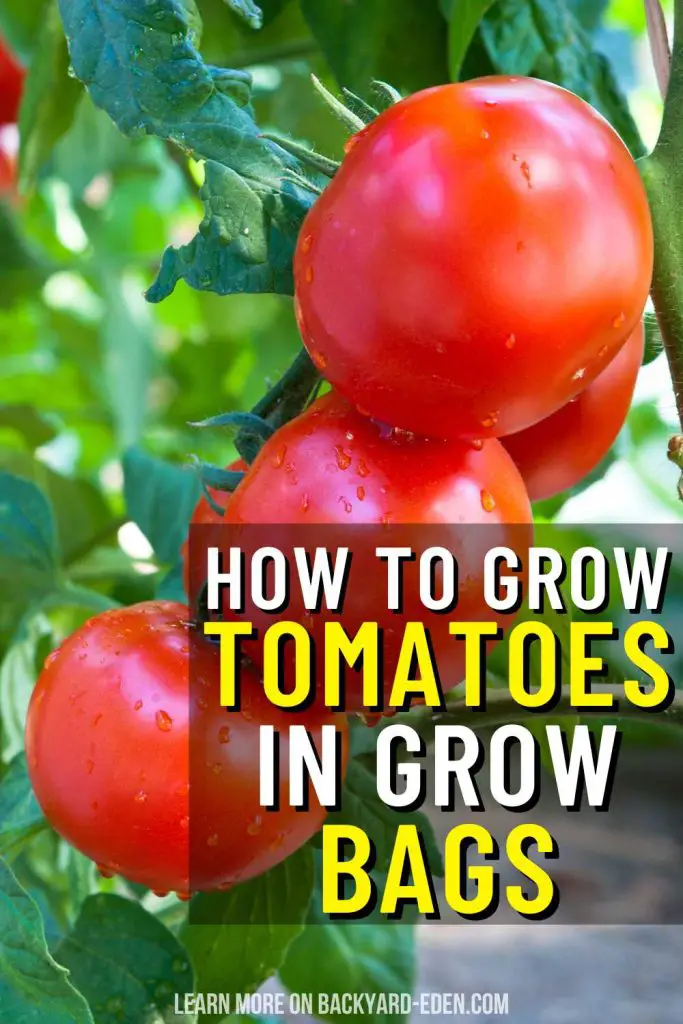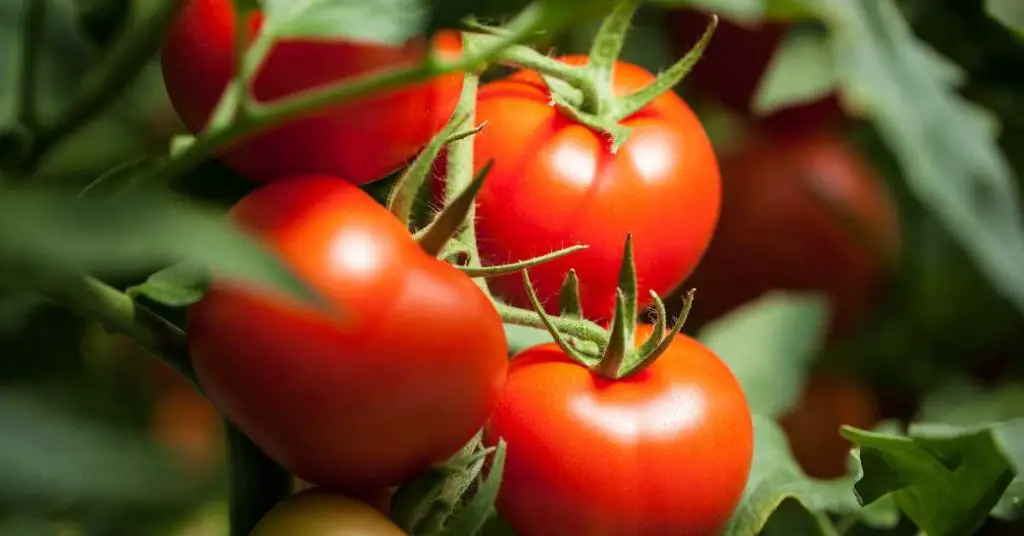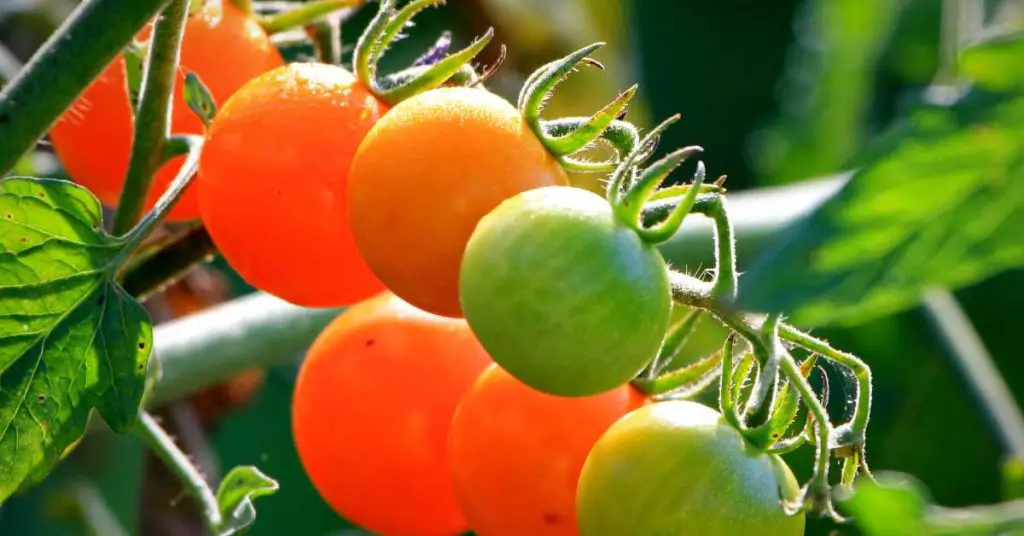Growing tomatoes in grow bags is a fantastic way to save space and manage soil conditions effectively. Whether you have a small patio or a large garden, grow bags allow you to move your tomato plants to get the best sunlight and protect them from soil-borne diseases.
Homegrown tomatoes are not only fresher but also tastier than those bought from a store, and they provide a sense of achievement that comes from growing your own food.
In this blog post, we’ll explore how easy and rewarding it is to grow tomatoes in grow bags, from the basics of setting up to harvesting your juicy tomatoes.

This post may contain affiliate links. Read our full disclosure here.
What You Need
To start growing tomatoes in grow bags, you’ll need a few essential items. Here’s a simple list to help you gather everything:
- Grow Bags: Choose bags that are at least 10 gallons in size for best results. Grow bags made from fabric are ideal because they allow good air circulation and drainage.
- Tomato Seedlings: Pick healthy seedlings from your local nursery or start them from seeds indoors.
- Soil: A high-quality potting mix is crucial. Look for one that is specifically designed for vegetables or tomatoes because it will have the right nutrients your plants need.
- Stakes or Cages: Tomato plants can get quite tall and heavy with fruit. You’ll need sturdy stakes or cages to support them.
- Water: Tomatoes require regular watering, so a watering can or hose is necessary.
- Fertilizer: Choose a fertilizer high in phosphorus and potassium, which are important for fruit development.
Gathering these materials will set the foundation for your tomato planting journey. Each component plays a vital role in ensuring your tomatoes grow healthy and produce plenty of fruit.
Step-by-Step Guide to Planting Tomatoes in Grow Bags
Choosing the Right Tomato Variety
Selecting the right variety of tomato to grow in your grow bags is crucial for success. Opt for dwarf or bush-type varieties which don’t grow too tall and are easier to manage in confined spaces. Some popular choices include ‘Bush Early Girl’, ‘Patio Princess’, and ‘Balcony’. These varieties are bred to perform well in containers and will thrive in your grow bag setup.

Preparing the Grow Bag
Before planting, ensure your grow bag is ready:
- Position the grow bag in a location that receives at least 6-8 hours of sunlight daily.
- Fill the bag with the potting mix, leaving about 2 inches from the top for easy watering.
- Moisten the soil slightly before planting to ensure it’s evenly wet.
Planting the Seedlings
When your seedlings are ready and the risk of frost has passed, it’s time to plant:
- Dig a hole in the soil large enough to accommodate the root ball of your tomato seedling.
- Remove the seedling from its container carefully to avoid damaging the roots.
- Place the seedling in the hole and fill it in with soil, pressing gently around the base to secure it.
- Space your plants about 24 inches apart to give them plenty of room to grow and access sunlight.
Staking and Support
Tomatoes need support as they grow to keep them upright and healthy:
- Install stakes or cages at the time of planting to avoid disturbing the roots later.
- Tie the stems gently to the support structure with soft garden ties or old pantyhose as they grow.
This step-by-step guide will help you plant your tomatoes correctly in grow bags, setting the stage for healthy growth and bountiful production.
Caring for Your Tomato Plants
Proper care is essential for your tomato plants to thrive and produce abundant fruit. Here’s how to ensure they get what they need:
Watering
Tomatoes in grow bags will require more frequent watering than those in the ground because the soil in bags can dry out quickly. Here are some tips:
- Water deeply to encourage strong root growth. Ensure water penetrates the soil rather than just wetting the surface.
- Check the soil moisture daily; it should be moist but not waterlogged. Water early in the morning to reduce evaporation and prevent disease.
Feeding
Feeding your tomato plants will help them grow robust and healthy. Follow these guidelines:
- Use a balanced fertilizer every two weeks, starting about two weeks after planting. You can switch to a tomato-specific fertilizer once the first fruits begin to form.
- Consider organic options like compost tea or fish emulsion to provide nutrients and support plant health.
Pruning and Maintenance
Pruning helps control growth and improves air circulation around the plants:
- Remove any suckers (small shoots that appear in the crotch between the stem and a branch) to direct energy into fruit production.
- Trim any leaves that touch the ground to prevent disease and improve air flow around the plant.
Pest and Disease Management
Keeping pests and diseases at bay is crucial for a healthy harvest:
- Inspect plants regularly for signs of pests or disease. Common issues include aphids, tomato hornworms, and fungal infections.
- Use organic pesticides or introduce beneficial insects like ladybugs to control pest populations naturally.
- Remove affected leaves or plants to prevent the spread of disease.
By consistently caring for your tomato plants with proper watering, feeding, pruning, and pest management, you can ensure a successful and fruitful growing season in your grow bags.
Harvesting
Knowing when and how to harvest your tomatoes is key to enjoying the fruits of your labor at their peak flavor. Here’s what you need to know:
- Observation: Watch your tomatoes closely as they ripen. Look for changes in color, texture, and size.
- Color: Most tomatoes will change color from green to their ripe hue, whether it’s red, orange, yellow, or another shade, depending on the variety.
- Texture: Ripe tomatoes should feel firm but give slightly when gently squeezed. They should also have a glossy sheen.
- Size: Different varieties will have different sizes at maturity, so refer to the seed packet or plant tag for guidance.
When your tomatoes meet these criteria, it’s time to harvest:
- Use scissors or pruning shears to cut the stem, leaving a small portion attached to the fruit.
- Harvest regularly to encourage continuous production. Tomatoes left on the vine too long may become overripe or attract pests.
Once harvested, enjoy your tomatoes fresh in salads, sandwiches, sauces, or simply on their own. Homegrown tomatoes are bursting with flavor and nutrients, making them a delicious addition to any meal.

Troubleshooting Common Problems
Even with the best care, tomato plants can encounter various issues. Here are some common problems you might encounter and how to address them:
Blossom End Rot
- Symptoms: A dark, sunken spot at the blossom end (bottom) of the fruit.
- Cause: Calcium deficiency or inconsistent watering.
- Solution: Ensure consistent watering and provide calcium supplements through fertilizers or foliar sprays.
Splitting
- Symptoms: Tomatoes split open as they ripen.
- Cause: Fluctuations in watering, especially after periods of drought followed by heavy rain.
- Solution: Maintain consistent watering to prevent sudden changes in moisture levels.
Leaf Discoloration (Yellowing)
- Symptoms: Yellowing leaves starting from the bottom of the plant and progressing upwards.
- Cause: Nutrient deficiencies, overwatering, or pests.
- Solution: Adjust watering practices, provide balanced fertilizer, and address any pest issues promptly.
Pests
- Symptoms: Holes in leaves, chewed fruits, or visible insects on the plants.
- Common Pests: Aphids, hornworms, caterpillars.
- Solution: Use organic pesticides, handpick pests, or introduce beneficial insects to control infestations.
Disease
- Symptoms: Wilting, yellowing, or spotting on leaves, and fungal growth.
- Common Diseases: Early blight, late blight, powdery mildew.
- Solution: Practice crop rotation, ensure good air circulation, and use disease-resistant varieties. Apply fungicides as needed.
Regular monitoring of your tomato plants and prompt action to address any issues will help ensure a healthy and productive harvest. Don’t hesitate to seek advice from local gardening experts or extension services if you encounter persistent problems.
FAQs
What Size Grow Bag is Best for Tomatoes?
Choose grow bags that are at least 10 gallons in size to provide ample space for root growth. Larger varieties may benefit from even larger bags to accommodate their extensive root systems and promote healthy plant development.
Ensure the bags have good drainage holes to prevent waterlogging, which can lead to root rot. Additionally, consider the space available in your garden or balcony when selecting the size of grow bags to ensure they fit comfortably in the designated area.
How Many Tomato Plants Can I Grow in One Grow Bag?
It’s generally best to plant one tomato plant per grow bag to give each plant enough space to grow and access nutrients.
Crowding multiple plants in a single grow bag can lead to competition for resources like water, nutrients, and sunlight, resulting in stunted growth and reduced fruit production.
By providing each tomato plant with its own grow bag, you allow it to establish a strong root system and develop to its full potential, ultimately yielding a bountiful harvest.
Do Tomatoes in Grow Bags Require More Water Than Those in the Ground?
Yes, tomatoes in grow bags typically require more frequent watering than those planted in the ground due to the limited soil volume in the bags.
The soil in grow bags tends to dry out more quickly, especially during hot weather, necessitating regular watering to keep the plants hydrated.
Monitor the moisture level of the soil by checking it daily and adjust your watering frequency accordingly.
It’s essential to water deeply to ensure the entire root system receives adequate moisture, promoting healthy growth and fruit development.
Can I Reuse Grow Bags for Growing Tomatoes Next Season?
Yes, you can reuse grow bags for growing tomatoes in subsequent seasons with proper preparation. Start by emptying the old soil from the bags and thoroughly clean them to remove any debris or residues.
Allow the bags to dry completely before storing them in a cool, dry place to prevent mold or mildew growth. Before planting tomatoes again, replenish the grow bags with fresh potting mix or compost to provide nutrients for the new plants.
Regularly inspect the bags for signs of wear and tear, and replace them if they become damaged or deteriorated over time.
What Should I Do If My Tomato Plants Are Too Tall and Falling Over?
If your tomato plants are tall and falling over, provide adequate support to prevent them from collapsing under their own weight. Install stakes or cages around the plants and tie the stems gently to the support structure using soft garden ties or twine.
This will help keep the plants upright and prevent them from bending or breaking. Additionally, consider pruning excessive growth to maintain a manageable size and promote better airflow around the plants, reducing the risk of disease.
How Can I Prevent Pests Naturally in Grow Bags?
Preventing pests naturally in grow bags involves using organic pest control methods to deter or eliminate harmful insects without resorting to chemical pesticides. Introduce beneficial insects like ladybugs, lacewings, or predatory mites to the garden, as they feed on common pests like aphids, thrips, and caterpillars.
Regularly inspect your tomato plants for signs of pest infestation and manually remove any insects you find. Practice good garden hygiene by removing fallen leaves and debris, which can harbor pests and disease-causing organisms.
You can also practice companion planting with herbs and flowers that repel pests, such as marigolds, basil, and garlic, which can help protect your tomato plants from insect damage.
Why Are My Tomato Leaves Turning Yellow?
Yellowing leaves on tomato plants can be caused by various factors, including nutrient deficiencies, overwatering, pests, or diseases. Conduct a thorough inspection of your plants to determine the underlying cause of the yellowing leaves.
Check for signs of nutrient deficiencies, such as pale or yellow leaves with green veins, and address them by providing balanced fertilizer or soil amendments. Ensure proper watering practices, allowing the soil to dry out slightly between waterings to prevent overwatering, which can lead to root rot and yellowing leaves.
Monitor your plants for pest infestations, such as aphids or spider mites, and treat them promptly with organic pest control methods if necessary.
Make sure to watch for symptoms of common tomato diseases, such as early blight or powdery mildew, and take preventive measures to protect your plants, such as applying fungicides or improving air circulation.
Can I Grow Tomatoes in Grow Bags Indoors?
Yes, you can grow tomatoes in grow bags indoors, provided they receive adequate sunlight or artificial grow lights. Choose compact tomato varieties suitable for indoor cultivation, such as cherry or patio tomatoes, as they require less space and are well-suited to container gardening.
Place the grow bags in a sunny location, such as a south-facing window or under grow lights, where they will receive at least 6-8 hours of sunlight per day. Ensure proper ventilation to prevent humidity-related issues and promote air circulation around the plants.
Regularly monitor the moisture level of the soil and water as needed to keep the plants hydrated. With proper care and attention, you can successfully grow tomatoes indoors in grow bags and enjoy a fresh harvest right from your own home.
Conclusion
Growing tomatoes in grow bags is a rewarding and enjoyable experience that anyone can undertake, whether you have a large garden or just a small balcony. By following the steps outlined in this guide, you can cultivate delicious tomatoes right at home, providing you with fresh and flavorful produce throughout the growing season.
Remember, success with growing tomatoes in grow bags requires attention to detail and consistent care. From selecting the right varieties to harvesting your ripe fruits, each step contributes to the overall success of your tomato garden.
So, roll up your sleeves, gather your materials, and get ready to embark on your tomato-growing journey. With a little time, effort, and patience, you’ll soon be enjoying the taste of homegrown tomatoes like never before.





